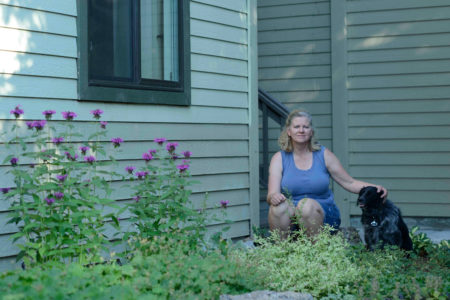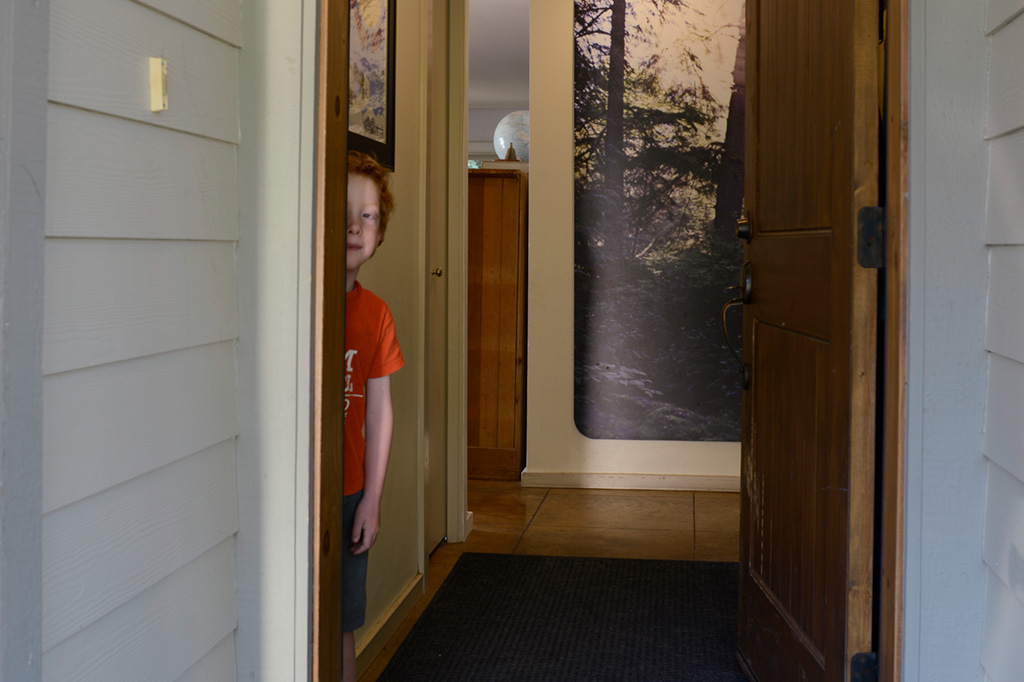Julie McGregor has outfoxed the Blaine County housing conundrum for more than a decade. Through the 2008 financial crisis, the exit of her longtime employer, Smith Optics, and the ongoing scourge of short-term rentals sucking up long-term housing, McGregor has weathered it all. With vacancy rates “catastrophically low” for nearly two years, according to ARCH Community Housing Trust Executive Director Michelle Griffith, McGregor’s trajectory on the time-space housing continuum is still as smooth as the brightest satellite coursing a stargazer’s limelight.
McGregor’s property at The Fields Condominiums, a mix of market-rate and workforce housing located “only steps away from the bike path and ski shuttle,” according to the Visit Sun Valley website, has been ideal for her. She secured her deed-restricted home as a Blaine County Housing Authority (BCHA) applicant.

Julie McGregor and her son on the patio of their home in The Fields in Ketchum. Photo by Chris Syms
“I sought it out because, at the time, I was a single person,” McGregor said during a cellphone conversation this summer as she and her 5-year-old son Gus were road-tripping to Lake Tahoe. “I was already working at Smith. I could afford it, and I didn’t have to have a roommate, but I was 85 on the waiting list. I thought it would be a couple of years before a place would free up for me to buy.”
BCHA helps allocate community housing that isn’t soley managed by private companies, fire departments, Sun Valley Company, Mountain Rides and other entities that trade in the increasingly precious commodity and not just at the public level. Rental offers barely make the classifieds lately. ARCH Community Housing Trust, on the other hand, is in the business of creating affordable housing and finding funding to support its projects, which increasingly include construction of both renter and owner-occupied units. The lion’s share is federal funds, Griffith said.
Much to McGregor’s surprise, almost as fast as she qualified, her Fields workforce unit freed up. McGregor said somehow she had bumped to the top of the BCHA list. Her unit’s first owner, Christine Davis-Jeffers, the current executive director of the Sun Valley Center for the Arts, had decided to sell and became a market-rate homeowner in Hailey. McGregor said at the time many of her working friends questioned the wisdom of getting involved with deed-restricted property where appreciation is capped.
“People were flipping houses and making gobs of money,” McGregor said. “I guess it’s a little like the tortoise and the hare. Things were chugging along, and then they fell apart. I’ve been ok all along.”
Her home is a two-bedroom, two-bath condominium with an open living concept. McGregor said that during her years in product development at Smith, she searched out market-rate opportunities, but nothing stacked up.
“I’m always, always looking, just because it’s a small condo,” McGregor said. “When I was at Smith, for sure, I was keeping my eye out. Becoming a little more house poor was an option, but for me it’s an amazing location. Gus’s school is nearby. We’re close to family friends, and the building’s only 13 years old. I can afford it, and it’s my own. You’re buffered on so many fronts.”
Of the 41 units at The Fields, 17 are deeded for community housing. McGregor said she and her market-rate neighbors appreciate the blend of affordable and full-market units that are mostly held by second-home owners.
“They like coming and seeing that there is a vibrant, year-round community,” McGregor said, adding that it’s also understandable that so many people are tapping into the short-term rental habit—it’s part of the financial juggling act that has been less restive for her since she’s in an affordable situation and isn’t always brainstorming some new way to make her mortgage payment.
It could be luck, but McGregor is also a savvy businesswoman. Nailing it, in her case, means she has been able to meet her financial obligations and live as she sees fit, even with the vagaries of global economics swirling around her. She says she has BCHA to thank for her success because workforce housing at The Fields, promoted and approved in conjunction with the City of Ketchum, has helped her maintain a low-stress housing situation, the key ingredient of a comfortable lifestyle.
Such a glowing experience is far from the norm, however. McGregor acknowledges that she’s unlikely to replicate what she has on the open market. It is fair to say the housing struggle has always been a part of resort-town living. Even Warren Miller camped in a parking lot here getting started as a filmmaker.
“I often say people take a $100,000 pay cut to live a $100,000 better life,” said Ketchum Mayor Nina Jonas, but what has been slightly tongue in cheek is quickly becoming legend, as teachers who can’t find housing, and even ski-bums who can’t find a long-term couch, bail on Blaine County. “In the long run, we have to have a variety of people in our community who live and work here. It’s frustrating. The answer isn’t to move
everybody south.”
Taxable property in Blaine County is valued at $9.3 billion today. Deed-restricted workforce housing is an infinitesimally small portion of that valuation. Support for community housing in Blaine County also pales in comparison to its Colorado contemporary, Pitkin County, home to Aspen, a resort community with a smaller population, but arguably more expensive real estate. BCHA has stewardship of 105 units, including 20 rental units. The Aspen/Pitkin County Housing Authority stewards more than 2,800 units with 1,500 as ownership properties. The Aspen experience has been undergirded by state statute, which supports a real estate transfer tax to feed community
housing needs.
Such a tax is not in play in Idaho, where the governor recently signed a bill, effective in January 2018, that “adds to existing law to limit regulation of short-term rentals and vacation rentals …,” meaning Idaho communities will be further hampered in most efforts to control the Airbnb effect that is dissolving so much long-term rental supply in Blaine County and making it harder for employers to fill jobs, according to a report sponsored by the City of Ketchum that was presented in August. If jobs-versus -rentals in the classifieds are a kind of balance sheet to economic health, the situation is totally out of whack considering the discrepancy in column inches for each side of the equation.

ARCH housing helped this two hard-working, professional Valley family relocate here.
The conundrum deepens as employers are forced to pay higher wages, which ultimately adds to the cost for developers who already must wrestle with higher land values, unless they’ve availed themselves of short-sale opportunities. Lately, higher wages haven’t resulted in solid hires because employees aren’t finding places to live. Several builders report losing employees to other cities because of the housing crunch, yet planners say they are seeing little in the way of creative solutions coming forward from developers.
Section 8 housing vouchers (from the Housing Act of 1937) provide federal rental housing assistance for low-income applicants. Currently, there are approximately 1,100 people on the voucher waiting list at the Idaho Housing and Finance (IHFA) office in Twin Falls. For those who qualify, the wait time can be up to two years. Federal low-income housing credits, created by President Reagan and Congress in the Tax Reform Act of 1986, account for some additional local public housing support. The U.S. Treasury Department is tasked with disbursing to the states $2.35 per person ($1.7 million for Idaho) in housing tax credits that qualified developers can use to negotiate with lenders for actual construction dollars. Idaho’s agent for distribution of federal support is IHFA. Developers, in turn, commit to provide affordable rental space. There are 32 Ketchum units in the workforce housing category developed as a single, high-density, multi-family apartment project, Northwood Place, adjacent to the YMCA. Approval of the development was negotiated through Ketchum’s Planned Unit Development and Development Agreement process, but federal housing tax credits pushed the project through.
“It leaves the equity in the project,” said Cory Phelps, IHFA vice president of project finance. “Units have to be rented to folks earning 60 percent of AMI (area median income) or below. The entire program is really meant to create affordable housing.”
Phelps said nationwide there is a great need for affordable housing that is barely being met. A bipartisan effort to double the housing credit, Senate Bill 548, is still with the Senate Finance Committee.
Ketchum’s incentive that allows development of greater square-footage when developers contribute community housing was challenged last winter by Boise City Councilman Scot Ludwig, a developer and attorney. Ludwig’s plans to develop a 16,500-square-foot property across from Perry’s Restaurant at the corner of First Avenue and Fourth Street in Ketchum, as the company Asset Enhancement, ran aground when Ludwig balked at the city’s rules for gaining a larger building envelope. Ludwig sued the city, seeking to have community housing in-lieu fees thrown out, but the case has since been withdrawn.
Around the country, inclusionary zoning, where communities mandate community housing with certain development, is common. When Sun Valley put such a rule on the books in 2005, requiring community housing or in-lieu fees for new development, the issue went to the state Supreme Court and the city lost. Ketchum, which was pursuing a similar program, then repealed its law, and refunded money that had been collected for that city’s own attempt at inclusionary zoning.
Tying up community housing funds as legal matters are sorted out has delayed progress with community housing development, but Jonas hopes the new housing crisis will help convince community leaders to pick up where her predecessors started. In 1969, a city resolution observed, “Employment in the Ketchum area has drastically increased, to the end that a severe housing shortage exists for low-income families.” That sounds familiar to all parties wrestling with the current crisis.
Ketchum planners of today recommend that the city immediately spend accumulated in-lieu fees ($1.7 million if the Auberge Resort and Residences, Sun Valley project goes forward as planned) on property to develop affordable housing. Blaine county towns still collect in-lieu fees and negotiate additions of some community housing, although the success of the matter often depends on the politics of the day. Before Jonas became mayor, fees were waived with construction of the Limelight Hotel. Sometimes it seems that there is little more than hope that developers will play along.
Another indication, despite much planning effort, that voter support of pro-housing policies is weak in Idaho, is the lack of public comment in favor of community housing, Griffith said.
“I think a carrot is better than a stick. Developers want to develop, and that’s ok. That’s what a free market allows,” Griffith said. “We need to provide strong enough incentives for developers to build affordable housing. Then, people need to advocate in favor of it. It would help decision makers if there was balance in the comments they hear.”
ARCH has secured some $10 million in grant funding, mostly federal, for several projects. Some have recently been completed and more are on the way, but participation in the effort has been fraught with peril for some.

Jeanne Brydges lives in Green Acres, a Hailey condominum. She was able to get into her home by buying through ARCH. Photo by Chris Syms
Green Acres homeowner Jeanne Brydges, who closed on her Hailey condominium in August 2008, has struggled with maintenance of an older building she bought through ARCH for $145,000, including a $35,000 IHFA grant. Her mortgage was based on the $110,000 balance after the grant, but she has been stuck with a 6.49 percent interest rate since she bought the property. Since property values dipped precipitously, Brydges has not been able to refinance since her assessment is based on the full purchase price, including the grant. Today, as the value of her property has rebounded, she has found a lender willing to refinance at 3.875 percent, slightly more than half the previous rate.
“I found my condo during an open house. I didn’t know anything about affordable housing. I liked the place, but I didn’t have any help. The first time I saw the paperwork was at the closing,” Brydges said, adding that she too has continuously searched for a market rate home that she could afford. During the downturn, although at times she was working three jobs, she was unable to make a move because she was locked into her ARCH home with values down. Presently, Brydges owes $93,600 and the loan takes a subordinate position to the IHFA grant, which expires in 2023. “My appraisal needed to be $130,000 to refinance.”
There have also been property management conflicts since two of the units in the building, set along the bicycle path, are market rate, and two are deed restricted. The respective owners face very different financial realities. “It’s literally north versus south,” Brydges said. “Sometimes I wonder if it would have been better to just walk away.”
Brydges has voluntarily paid additional HOA dues to help cover painting, which still hasn’t been organized, but she has made improvements to her own space in the building that she said she still loves and is grateful to own.
“I sold my (Toyota) Matrix and bought beautiful new windows,” Brydges said.


